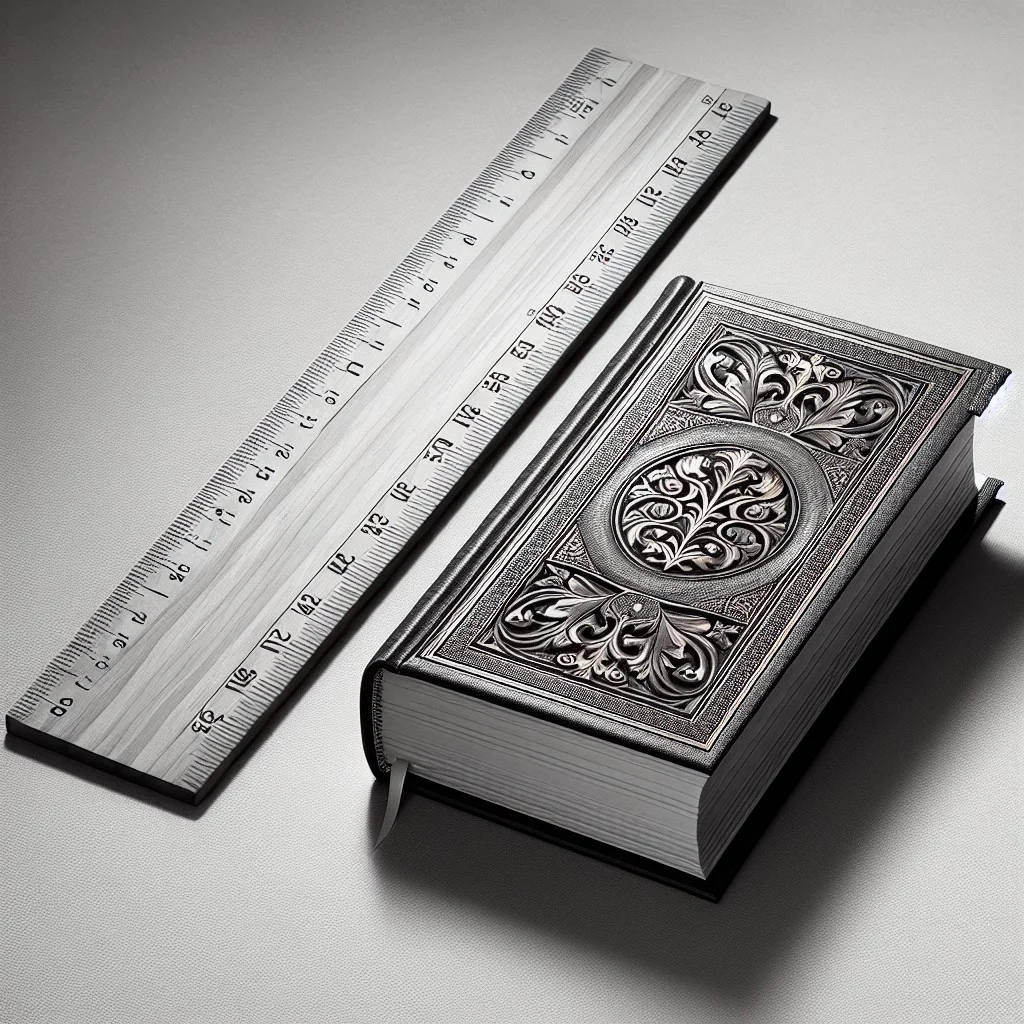Last updated on
Unravel the mystery of measurements as we delve into the practical world of unit conversion, providing a clear, real-world understanding of what 25cm looks like.
Key takeaways:
- 25 cm is about the width of a standard ruler.
- It is the approximate length of a large carving knife or the diagonal screen size of a small tablet or large smartphone.
- A DVD case or the length of a large chef’s knife is roughly 25 cm.
- In sports, the width of a balance beam or the diameter of a basketball rim is close to 25 cm.
- Fashion items such as clutch bags, wallets, and belts often measure around 25 cm.
What's Inside
Cm in Everyday Objects

Spotting 25 centimeters in the realm of everyday objects provides a solid, tangible point of reference. Consider a standard A4 sheet of paper. Its shorter side is just shy of 30 cm, so envisioning that length slightly reduced gets you close. Now, picture a ruler, a quintessential tool found in many desk drawers; it’s often 30 cm in length, with 25 cm marked just before its end.
For a culinary comparison, the typical length of a large carving knife comfortably sits at this measurement. If you’re more of a tech enthusiast, the diagonal screen size of a small tablet or a large smartphone is frequently around 25 cm, offering a modern touchstone for visualizing this dimension. Next time you lace up your shoes, consider their length; many adult-sized shoes will measure within this ballpark. So, whether you’re in the kitchen, office, or out and about, these everyday items provide a ready yardstick for gauging 25 centimeters.
Common Household Items Measuring 25 Cm

Imagine aligning the long side of a standard A4 paper; it measures just shy of 30 cm, which means 25 cm is a tad shorter. Picture a typical ruler, which often comes in either 30 cm or 12 inches in length. The 25 cm mark is easily visualized as just 5 cm from the end of this everyday measuring tool.
In the comfort of your living room, a DVD case provides a close approximation since it’s about 19 cm tall—consider it with an extra stack of a few CDs on top to reach the 25 cm mark. If you’re in the kitchen, a standard loaf of sandwich bread is also roughly this size, as well as the length of a large chef’s knife blade.
Ever lost a remote control? They’re often just about 25 cm in length as well. Understanding this measurement can also help ensure you’re getting the right-sized picture frames or wall decorations, as these items frequently come in dimensions that include 25 cm as either the height or width.
By relating 25 cm to these everyday items, you gain a tangible understanding of the measurement, enabling you to better estimate sizes and dimensions in a variety of situations.
Visual Comparisons to Understand 25 Cm
Imagine a standard ruler, often found in stationary kits; its length is usually 30 cm, so 25 cm is just a tad shorter.
If you don’t have a ruler at hand, picture a large paperback book—it’s about the same length.
Need something more tangible? Take two credit cards and place them end to end; that’s approximately the distance you’re looking at.
Another relatable example is the width of a regular microwave oven door which tends to hover around the 25 cm mark.
While out and about, a glance at a smartphone—especially the larger models—will give you a good sense of this size, as most are near this measurement diagonally.
These everyday comparisons create a handy mental image to gauge 25 cm without reaching for a measuring tape.
Cm in the Animal Kingdom
Envision a small dog, such as a Chihuahua, from paw to shoulder – this often matches the 25 cm mark. Alternatively, picture the length of an average adult zebra finch, from beak to tail feather, another living embodiment of this measurement.
Hummingbirds, astonishing in their agility, have a wingspan that can stretch close to this size. This dimension is also comparable to the claw span of a large crab, a common sight along rocky shorelines. By associating 25 cm with creatures that are familiar, the abstract becomes concrete, providing a tangible grasp of scale within the natural world.
Sports Equipment Sized At 25 Cm
When considering the realm of sports, precision in measurements is often as crucial as the skills of the players themselves. It might be surprising to discover that various equipment from this world aligns closely with the 25-centimeter mark. Take, for instance, a standard diameter of a basketball rim—it’s just shy of this figure at about 24 cm. This is crucial for the game; the slight difference between the ball and the rim width allows for that satisfying swish as the ball glides through.
Meanwhile, on the badminton court, shuttlecocks fall into this range when including their feathers, which extend the overall length, adding to the drag and influencing the game’s tempo. If you delve into the gear used in gymnastics, 25 cm is right around the measurement for the width of a balance beam. This slim margin is intentional, providing gymnasts with just enough surface area to perform, while still demanding precision and balance.
These instances exemplify how essential 25 cm is in sports—often representing the fine line between function and challenge, margin and error. Understanding this measurement’s practical application offers a deeper appreciation for the design and the rules that define athletic competitions.
Fashion Items Measuring 25 Cm
A clutch bag or a small handbag often falls into this size range, perfect for your essentials. Men’s standard-size wallets are slightly shorter, but women’s long wallets, particularly those designed to accommodate phone and checkbook, frequently hit the 25 cm mark.
Shoe lovers might recognize 25 cm as a typical measurement for a women’s size 8.5 shoe in the US. This helps when shopping online to ensure the shoe rack or storage space is sufficient.
Belts can also provide a good frame of reference, as 25 cm usually covers a substantial part of a standard belt length, helping to visualize waist sizes and spacing for belt notches.
Fashion scarves are another example, with 25 cm about a third of the width of an average square silk scarf—leading to an understanding of how it might drape around the neck or shoulders.
In jewelry, a necklace with a 25 cm drop would hang mid-chest, offering a clue on pendant placement when worn.
How to Use a Ruler to Measure 25 Cm
Using a ruler to measure 25 cm is a straightforward process:
Select the right tool: Make sure you have a ruler long enough to measure 25 cm. Most standard rulers are 30 cm, which is ideal for this task.
Starting point matters: Position the “0” mark of the ruler at the edge of the object you’re measuring to ensure accuracy.
Read the ruler correctly: Look carefully for the mark labeled “25” on the ruler. The numbers are typically centimeters, and every tenth line will be numbered, representing 1 cm increments.
Maintain alignment: Keep the ruler straight and parallel to the edge of the object, avoiding any slanted measurements that could lead to inaccuracies.
Jot it down: If necessary, make a small mark at the point where the 25 cm measurement falls to have a clear indication of the length.
Remember, practicing precision when measuring will help ensure you get the correct size every time.
Convert 25 Cm to Inches: A Quick Guide
To convert 25 centimeters to inches, consider that one inch is equivalent to 2.54 centimeters. Divide the length value by this number for an accurate conversion.
1. Start by writing down 25 centimeters.
2. Divide this number by 2.54, the conversion factor.
3. The result is approximately 9.84 inches.
For quick mental conversions, you might round 2.54 centimeters down to 2.5 to make the math easier, acknowledging a slight loss in precision.
Visualize the conversion this way: If you stack two rulers side by side—one metric, one imperial—the 25 cm mark on the metric ruler aligns closely with the 10-inch mark on the imperial ruler, just slightly shy of it.
Remember to double-check your conversions, especially in situations where precision is critical. Utilize online calculators or conversion tools for convenience and accuracy. Keep this conversion in mind for future reference as it’s a common measurement useful in a variety of contexts.
Understanding the Metric System: 25 Cm Explained
The metric system simplifies measurements with its base-10 structure. Here’s what that means for understanding 25 centimeters (cm):
- Base Units: The meter is the fundamental unit of length in the metric system. Centimeters are one hundredth of a meter, hence the ‘centi’ prefix, which means one hundred.
- Decimal Simplicity: Since the system is decimal, converting between units just means shifting the decimal point. To convert 25 cm to meters, you move the decimal two places to the left, resulting in 0.25 meters.
- In Daily Life: The ubiquitous use of the metric system worldwide means that a 25 cm measurement is universally understood, whether you’re buying fabric in Tokyo or measuring rain in Paris.
- Relatable Examples: For practical visualization, consider a standard long ruler, which is typically 30 cm. Twenty-five centimeters is just a tad shorter.
- Cohesion with Other Units: Centimeters fit cohesively with other metric units – millimeters (mm), meters (m), and kilometers (km) – easing scientific and mathematical calculations.
Understanding the metric system underpins our grasp of measurements like 25 cm, enabling us to navigate both the scientific and the everyday world with precision.
Practical Exercises: Converting 25 Cm Into Inches
Practical exercises are a brilliant way to cement understanding, and converting centimeters to inches is a skill that’s both useful and simple to acquire with a bit of practice.
1. Straight Conversion Method: Remember that 1 inch equals approximately 2.54 centimeters. To convert 25 cm into inches, divide the number of centimeters by 2.54. Doing the math, 25 ÷ 2.54 results in about 9.84 inches.
2. Use Daily Objects: Identify objects that are about an inch long—like the width of an average pinky finger or a standard USB drive—then see how many of them it takes to span the length of a 25 cm object. It’s a tangible way to understand the dimension in inches.
3. Conversion with a Calculator: Utilize a calculator or a mobile conversion app. Simply input 25 cm and let the technology calculate the equivalent inch measurement. This not only reaffirms the conversion but also introduces handy digital tools.
4. Interactive Online Converters: Visit educational websites with measurement conversion tools. They often allow you to input centimeters and instantly provide the inch conversion, reinforcing the straight conversion method.
5. Create a Conversion Chart: Craft a visual chart that lists centimeters and their inch equivalents. Referencing this chart can strengthen your ability to quickly gauge the length in inches without doing the actual conversion.
By practicing these exercises, the concept of converting 25 cm to inches becomes second nature, and the more you practice, the easier it becomes to visualize and understand the equivalent measurements.
FAQ
What does 25 centimeters look like?
25 centimeters, which is just shy of 10 inches, can be visualized as slightly shorter than the typical 12-inch long ruler.
What 25 cm in inches?
When converted, 25 centimeters is approximately equivalent to 9.84252 inches.
How big does a centimeter look?
A centimeter can be visualized roughly as the width of a standard pencil, the length of a staple, the combined width of five stacked CDs or DVDs, the thickness of a standard notepad, or the radius of a U.S. penny.
What are some common things that measure approximately 25 centimeters?
A standard ruler, a large adult shoe, and the average length of a guitar neck are all items that commonly measure approximately 25 centimeters.
How does a measurement of 25 centimeters compare to the average handspan?
A measurement of 25 centimeters is generally larger than the average handspan, which is approximately 19 centimeters for adult men and slightly less for adult women.
Is 25 centimeters an often-used length in the fields of architecture or design?
No, 25 centimeters is not commonly used in architecture or design as standard measurements in these fields are usually given in meters or feet.




